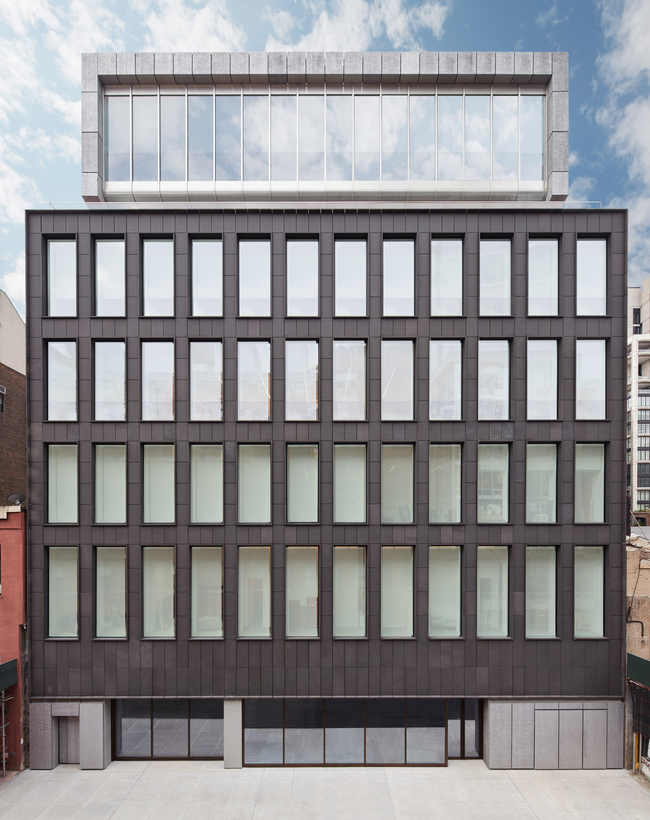Along with the September 2019 opening of its aluminum-clad headquarters at 540 West 25 Street came the monumental announcement that Arne Glimcher, who founded Pace Gallery exactly 60 years ago, was finally passing the torch to his second son, Marc.
Having grown up traipsing through artists’ studios with his father, breathing the business as a boy, Marc, 56 and the C.E.O. and president of Pace since 2011, has worked on and off at the gallery since 1985. (“Off” periods include two years spent teaching grade-school science in New Mexico in the late 90s following a disagreement with Arne about taking the reins.) More recently, it was Marc who spearheaded the completion of the gallery’s new building, designed by Dominic Kozerski and Enrico Bonetti of Bonetti/Kozerski in collaboration with Pace and Weinberg Properties, though he refuses to take the credit. “That would be an egomaniacal thing to say,” the younger Glimcher says. “But it did require one person to push the idea, and that was me.”
Jeans v. Suit
It’s impossible to think about Marc without Arne coming into the picture, yet in many ways the two couldn’t be more different. While Arne can look buttoned up and elegant in a polo shirt and jeans, Marc makes a suit (no tie!) look casual. And while Arne built solid relationships with some of the 20th century’s most famous artists—Jean Dubuffet, Louise Nevelson, Agnes Martin, and James Turrell among them—Marc diversified the roster, adding contemporaries such as teamLab, Loie Hollowell, Adam Pendleton, and, most recently, Torkwase Dyson.
This dichotomy can be quite startling. In 1993, when Arne was featured in a New York Times Magazine cover story, he was pictured surrounded by his team of artists—Donald Judd, Claes Oldenburg, Chuck Close, Lucas Samaras—all white males, though the gallery was already representing Martin, who did not appear. In December 2019, when Vanity Fair ran a group portrait of 50 of the gallery’s current artists, Fred Wilson, who is African-American, was prominently featured, standing beneath one of his Murano-glass black chandeliers, surrounded by a highly diverse community flown in from around the world.

Hong Kong, Seoul, Geneva, London, and Palo Alto—Marc Glimcher has brought a global reach to Pace, establishing galleries in key locations. Despite differences with his father, Marc feels an affinity with him and sees his own accomplishments as a continuation of what Pace has always been. “The building is so important because we are going in a certain direction. But it has been going that way for a very long time,” says Glimcher, noting that his father was the first gallerist to bring in specialists and scholars, resulting in museum-quality shows.
Art Nouveau
That sensibility continues under Marc, who has assembled a small team of curators—not sales directors—led by Andria Hickey, formerly of MOCA Cleveland, and Mark Beasley, whom he lured from the Hirshhorn Museum to direct the gallery’s performance program, Pace Live. The ultimate test for Marc will be whether he can establish the kind of loyalty from his artists that Pace is known for.
Ridgewood-based artist Hollowell, 36, tells me she loved the way Marc talked about art even in casual conversation when she first met him at a party. Hollowell’s solo exhibition of colorful geometric abstractions referencing her pregnant body was one of the opening shows in the new space. Meanwhile, Pendleton, 36, who invented “black Dada,” and whose work is set to fill the atrium of New York’s Museum of Modern Art starting in July, will be Pace’s solo presentation at the A.D.A.A. Art Show this weekend. “Pace is very much a family gallery,” says Pendleton. “It felt like I was joining a very established gallery, but an established gallery with a young leader, and that leader was Marc.”
The ultimate test for Marc will be whether he can establish the kind of loyalty from his artists that Pace is known for.
Joining the gallery in 1983, two years prior to Marc’s arrival, Julian Schnabel, whose work goes on display at Pace next month, may have the longest perspective. “I think Marc understands and has compassion for the arts. I don’t think he just sees this as business,” says the painter and filmmaker. “Also, I think he’s trustworthy.”
Regarding his prevailing taste for artists like teamLab, a Japanese phenomenon that creates interactive digital environments of astonishing beauty, attracting thousands to its shows, Marc says, “People often ask me, ‘Are you going with teamLab and Studio Drift because you’re shifting from high art to popular culture?’ I have a resounding no! What’s changing the art world is what always changes the art world—it’s the artists. We can rail against them all we want if we want to be left in the dust of history. And I don’t intend to do that.” —Barbara Pollack

